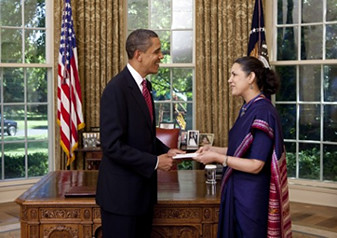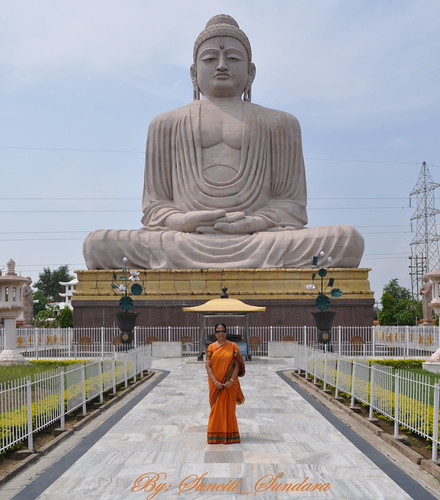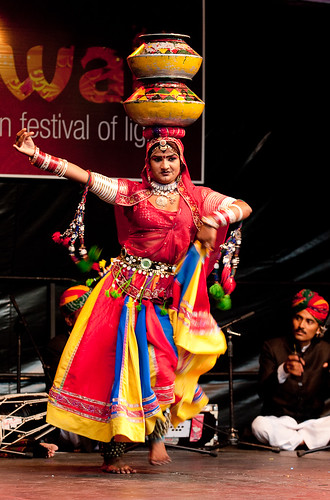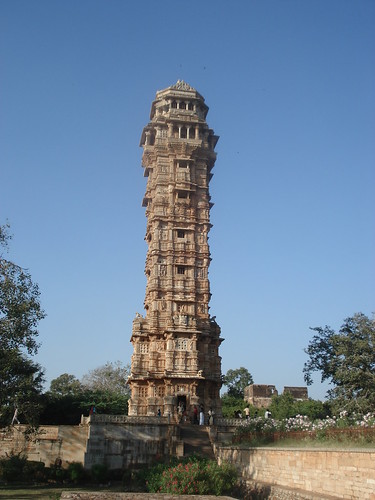Saturday, October 30, 2010
Wednesday, October 20, 2010
Trinidad and Tobago: Diwali celebration and other facts

Photo: The Hindu Temple complex and the 26-meter-tall (85 ft) Hanuman Statue, the tallest Hanuman Murti outside India, in Central Trinidad

Photo: Divali Nagar (City of Lights), located in the town of Chaguanas, where the annual exposition of Hindu and Indo-Trinidadian culture, associated with the celebration of Diwali in Trinidad and Tobago, takes place
The Republic of Trinidad and Tobago, the birthplace of Steelpans (steel drums or pans), Calypso (Afro-Caribbean music), Soca (soul calypso) limbo (a popular form of contra dancing), and well-known for its Carnival, is also one of the countries outside India that celebrate Diwali in a significant manner.
Trinidad and Tobago is an archipelagic country situated in the southern Caribbean, northeast of the South American country of Venezuela and south of Grenada in the Lesser Antilles.
The country consists of two main islands, Trinidad and Tobago, and numerous smaller islands covering an area of 5,128 square kilometers (1,980 squire miles). Most of the country's population (96% of 1,229,953 people as of July 2010 est.) lives in Trinidad and 4% of the population reside in Tobago.
Two major ethnic groups in the country are the Indo-Trinidadians and the Afro-Trinidadians in Trinidad, and Indo-Tobagonians and Afro-Tobagonians in Tobago, accounting for about 80% of the population. According to the 2000 census, people of Indian origin (South Asians) make up 40% of the population, the rest of the population being African 37.5%, mixed 20.5%, others 1.2%, and unspecified 0.8%.
Indo-Trinidadians (about 40%) constitute the country's largest ethnic group. They are primarily the descendants of indentured workers from India, brought here by the colonial rulers to work mainly in sugar plantations.
About half of the people of the Indian community follow their original native religions, and the rest have converted to Christianity, or have no religious affiliations (including atheists and agnostics). Through many cultural and religious groups, Trinidadians of Indian descent maintain many of their customs, traditions and rituals.
A major festival of Trinidad and Tobago that stands out is the Diwali Nagar exposition (also spelled Divali Nagar, meaning City of Lights), an annual exposition of Hindu culture broadly, and Indo-Trinidadian culture specifically, staged at the Divali Nagar Site, located in the town of Chaguanas.
Diwali Nagar exposition mainly features stage performances by east Indian cultural practitioners, a folk theatre featuring skits and plays, an exhibition on aspects of Hinduism, displays by various Hindu religious sects and social organizations, nightly worship of Goddess Lakshmi, lighting of Diwali diyas (lamps), performances by various schools related to Indian culture, and a food court serving Indian and non-Indian vegetarian delicacies.
The Diwali festival culminates with magnificent fireworks displays ushering in Diwali. Thousands of people participate in the celebrations in an atmosphere devoid of alcohol and in a true family environment.
The influence of Hinduism can be seen in the Hanuman Murti statue and Hindu Temple complex in Central Trinidad, which is famous for the tallest Hanuman Murti (26 meter/ 85 feet) outside India.
Followers of Hinduism constitute only 22.5% of the population, while the rest of the people are Roman Catholic (26%), Anglican (7.8%), Baptist (7.2%), Pentecostal (6.8%), Muslim (5.8%), Seventh Day Adventist (4%), other Christians (5.8%), others 10.8%, unspecified (1.4%), and people following no religions (1.9%) as per the 2000 census.
The main languages of Trinidad and Tobago are English (official), Caribbean Hindustani (a dialect of Hindi), French, Spanish and Chinese.
Tuesday, October 19, 2010
Christchurch Diwali Festival 2010
Photo: A Rajasthani dancer performs at the Christchurch Diwali Festival
New Zealand, an island country in the south-western Pacific Ocean situated about 2,000 kilometers (1,200 miles) southeast of Australia across the Tasman Sea, is noted for its multiculturalism. Though the majority of New Zealand's population is of European descent, the indigenous Maori are the largest minority, followed by Asians and non-Maori Polynesians, especially in urban areas.
New Zealand ranks highly in international comparisons on many topics, including education, economic freedom, and most importantly lack of corruption and its cities also consistently rank among the world's most livable cities.
Though New Zealand is culturally and linguistically part of Polynesia, contemporary New Zealand culture is mainly derived from British roots, with significant influences from American, Australian and European cultures, and recently non-Maori Polynesian and Asian cultures.
New Zealand's fastest growing ethnic groups are Asians, who celebrate festivals like the Auckland Lantern Festival, Indian festivals such as Diwali, and festivals of other Asian traditions. Large festivals, in celebration of Diwali and Chinese New Year, are held in several of the larger centers. The world's largest Polynesian festival, Pasifika, is an annual event in Auckland.
Monday, October 18, 2010
Sheila Dikshit: Corrupt Games officials can't get away
In an interview with NDTV, the Delhi CM Sheila Dikshit said that the corrupt Commonwealth Games officials cannot get away. She also said that the Capital now has the experience to conduct the Olympics, but she won't be there, when it happens.
Diwali and the myth of Narakasura

Photo: Krishna and Satyabhama fighting Narakasura's armies, painting from the Metropolitan Museum of Art, New York City, USA.
Deepavali (Divali or Diwali) literally means ‘row of lights’. According to one legend, the festival is celebrated on the occasion of Lord Krishna and his wife Satyabhama killing the Demon Narakasura. Another legend says the festival is celebrated on the occasion of return of Lord Rama and Sita to the Kingdom of Ayodhya after fourteen years in exile.
In Hindu mythology, Narakasura (or Naraka) is the Asura (demon) son of Goddess Earth (Bhudevi or Bhumi) and Lord Vishnu in his Varaha (boar) Avatar (incarnation). Some other legends say that Narakasura is the son of the Asura, Hiranyaksha.
Narakasura established the kingdom of Pragjyotisha in Assam defeating the last of the Danava king Ghatakasura. As it was foretold that he would be killed by a later incarnation of Vishnu, Goddess Earth sought a boon from Vishnu that her son should have a long life, and he should be all powerful. Vishnu readily granted these boons.
In the history of Assam, Narakasura is cited as the progenitor of many dynasties that ruled Kamarupa in its golden times. He is also associated with the myth of the Shakta Goddess and the place of worship, Kamakhya.
Narakasura joined forces with another Asura, Banasura, and brought all the kingdoms on earth under his rule, conquered Swargaloka, and defeated Indra. Thus Narakasura became the overlord of the heavens and the earth. Also, he abducted and imprisoned 16,100 women in his palace. Besides, he stole the earrings of Aditi, the heavenly mother goddess, and usurped her territory.
Defeated and helpless, the Devas, led by Indra, complained against Narakasura to Lord Vishnu who promised that he will mitigate their plight when he will be incarnated as Lord Krishna.
During the Krishna Avatar of Vishnu, Aditi, who was a relative of Satyabhama (an Avatar of Bhudevi), approached Satyabhama for help. Upon this, because of Narakasuara's ill-treatment of women and Aditi, Satyabhama asked Lord Krishna’s permission to wage a war against Narakasura.
As promised to the Devas and Aditi, Krishna attacked the fortress of Narakasura, riding his mount Garuda with wife Satyabhama. The battle was fierce, as Narakasura unleashed his huge armies of Asuras on Krishna. But the Lord slew them all, and killed Mura, Narakasura's general, because of which Krishna is also called Murari (the enemy of Mura).
In desperation, Narakasura launched Sataghni (a thunderbolt) on Krishna, but it made no impact on Krishna. Finally, when Narakasura tried to kill the Lord with a trident, Krishna beheaded him with his Sudarshana Chakra.
Before dying, Narakasura requested a boon from Krishna that his death anniversary be celebrated by all people on earth. So, the day of his death is celebrated as 'Naraka Chaturdashi', the first day of Diwali.
In another version, Narakasura had gained a boon from Brahma that he would die only at the hands of his mother. So, Satyabhama, along with Krishna, fought Narakasura bravely, but she was no match to him. When Narakasura got a chance, he took aim at Krishna, hurting him lightly. Krishna fainted in a preordained, divine plan adopted to empower Satyabhama.
On seeing the fainted Krishna, Satyabhama was furious, fought fiercely, and killed the demon finally. Before dying, he requested a boon from his mother (Satyabhama) that everyone should celebrate his death with colorful lights. Thus this day is celebrated as the first day of Diwali, 'Naraka Chaturdashi'.
The victory on Narakasura resulted in freedom for all his prisoners, and honoring of Aditi and Lord Krishna rescued all the 16,100 imprisoned women, and married them to restore their former dignity.
Kandeels: paper lanterns lighted during Diwali


A Kandeel [Sanskrit: Akasha Deepa (lantern of the sky), Kannada: Goodu Deepa (Nested light) or Nakshatra Gudu (Star like nest)], is a colorful decorative lantern made of wooden frame and covered papers. These are generally hung in front of homes during Diwali (or Deepavali meaning Festival of Lights), sometimes for around a month from the first day of Diwali.
Kandeels are traditionally built in a crystal shape with tails at the bottom. But in modern times, people created Kandeels in different shapes of stars, globes, airplanes, or any shape that suits their imagination, but the central idea is to make the Festival of Lights more impressive and colorful.
Diwali (also spelt Divali) is an important five-day festival in Hinduism, Sikhism and Jainism, and celebrated in India, Guyana, Trinidad & Tobago, Mauritius, Malaysia, Nepal, Singapore, Sri Lanka, Myanmar, Fiji, Surinam, and other places where people of Indian origin and/ or Hindu/ Sikh/ Jain faiths live.
Sunday, October 17, 2010
Meera Shankar: First Indian Female Ambassador to USA in 60 years

Photo: Meera Shankar presenting her credentials to President Barack Obama
India has now the first woman ambassador to Washington in 60 years; Meera Shankar, a career diplomat who was till recently posted in Germany.
Shankar, an Indian Foreign Service officer of the 1973 batch, succeeded Ambassador Ronen Sen. Earlier she had served as Director in the Prime Minister’s Office (1985-1991), Ministry of Commerce (1991-1995), and in the Ministry of External Affairs.
Now some of the core areas of her work involve India’s commercial negotiations with US companies for the supply of nuclear equipment under the landmark India-US civil nuclear deal, according to Meera Shankar’s statement to the press.
India’s nuclear spend is estimated at $150 billion, on which the US companies hoped for a major pie, but the biggest dampener for them turned out to be India's tough nuclear liability legislation that makes suppliers also potentially liable for eighty years.
Describing the deal as an instrument of transformation in India-US relations, Shankar said the growing defence cooperation between the two countries also reflected deeper mutual trust. ‘Bilateral defence trade between the two countries had rapidly risen to over $ 4 billion in the last few years with another $4 billion in the pipeline through the FMS route’, she said in an address on Tuesday on "Indo-US Relations: An Evolving Partnership" at Elliott School of International Affairs, George Washington University.
Another core area on which Shankar needs to concentrate on India’s interests is highlighting Indo-US common concerns of about terrorism and the closer counter-terrorism cooperation, the focus now being on strengthening exchange of intelligence and information sharing best practices and capacity building.
Thursday, October 14, 2010
Delhi 2010: Meet the Discus Divas of India
This video by NDTV shows the winning trio of Krishna Poonia, Harwant Kaur and Seema Antil speeking to NDTV after winning the gold, silver and bronze medal respectively in the Women's Discus Event and giving India its first sweep of all the 3 medals in the Commonwealth Games Delhi 2010.
Friday, October 8, 2010
Monday, October 4, 2010
Meditating Buddha at Bodh Gaya

Meditating Budha in Bodh Gaya, Was HE doing it under Hot Sun?, originally uploaded by Sunciti_Sundaram.
Photo: The giant marble statue of Buddha in deep meditation at Bodh Gaya. For more info about the photo and the photographer, click on the photo.
CWG Delhi 2010: The Giant Helium Balloon

HRH The Prince of Wales & HRH The Duchess of Cornwall in India 2-5 October 2010, originally uploaded by UK in India.
The huge helium filled aerostat balloon was a major attraction at the opening ceremony of the Commonwealth Games 2010 at the Jawaharlal Nehru Stadium, New Delhi. As at seven in the evening, spell-binding fireworks lit up the sky heralding the opening ceremony, the aerostat lifted up from the centre of the stadium with huge puppets hanging from the balloon that remained suspended above the main stage at a height of 25 meters above the ground.
During the entire ceremony that lasted over three hours, revolving images of the action on the ground was projected on the helium balloon while the special light effects continuously change its colors. The lights were programmed to bounce off mirrors on the aerostat while sound effects of the magnitude of 500,000 watts was used to make it more spectacular and spell-binding, to the amazement of over 60,000 spectators.
The aerostat, manufactured by Per Lindstrandt and designed by Merk Fsher, is the biggest helium balloon in the world used for the first time for an event like this. The balloon is of the diameter 40 meters x 80 meters x 12 meters approximately and is reported to cost Indian Rs 70 crore.
CWG Delhi 2010: Let The Games Begin
With one of the grandest ever opening ceremonies on Sunday at the Jawaharlal Nehru Stadium in New Delhi, India showcased to the world the spirit of the games, Indian culture and tradition, music, rhythms, dance, colors, diversity of its culture and lifestyles, and above all its technological advancements.
The Prince of Wales, Prince Charles, the representative of the Queen, inaugurated the opening ceremony of the 2010 Commonwealth Games by reading out the message from the Queen and declaring the games open in the presence of 60,000 spectators, participants and officials from 71 countries and territories, heads of states and other dignitaries from various countries. Prince Charles, said, "Ladies and Gentlemen, I have much pleasure in declaring the nineteenth Commonwealth Games open."
Prime Minister Dr. Manmohan Singh, present for on the occasion of opening ceremony of Delhi 2010 the along with his wife Gursharan Kaur, graced the occasion with a brief speech, "From all our countrymen, I convey my warm greetings to each member of this august gathering of Commonwealth sporting fraternity… I invite all our guests who have come from every corner of the world to enjoy our hospitality, to enjoy games, to enjoy the incredible sites and sounds of India. Millions of people are waiting eagerly to watch this great sporting spectacle unfold."
The games commenced when the President of India Pratibha Devisingh Patil announced, "Let the Games begin," after her brief speech declaring the games open.
The opening ceremony of the 11-day sporting extravaganza, Commonwealth Games Delhi 2010, was marked by a grand cultural extravaganza, dance, music and fireworks; a magnificent opening ceremony showcasing a glimpse of India's great heritage and tradition through light, music and dance show.
Sunday, October 3, 2010
CWG opening ceremony: tight security blanket over Delhi
The countdown to the Commonwealth Games is almost over, the Opening Ceremony is minutes away but it is a virtual shutdown in the Capital because of restrictions on the roads to protect the games venues from any security threats. Over 6000 specially trained men who were trained by the NSG are also deployed. View the video for a full report.

